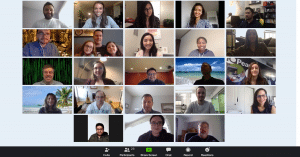How to Use Virtual Workshops to Co-create With Clients

The adoption and success of new digital tech products is driven equally by user experience and functionality. Let’s focus on the former. Businesses are turning to UX/UI in order to drive engagement, ensure usability, and improve the “stickiness” of their products. But great user experiences start with co-creation and ideation, both of which are challenging for remote teams – the universal blog post theme du jour. Much has already been said on that topic recently, nevertheless, our process for group ideation with clients via virtual workshops is simple and tested, so we wanted to share it.
Here are three principles for leading collaborative virtual workshops with clients and customers:
- Customer Connection
- Co-Creation Focus
- Stay Nimble
CUSTOMER CONNECTION
- Be empathetic (put yourself in their shoes) and understand the vision.
- Understand the business goals but also the qualitative, individual goals.
- Have a clear communication strategy and proactively drive toward that strategy.
- Break down larger deliverables into elemental components (agile methodology) and present design iterations continuously.
- Encourage written feedback for the sake of clarity and accountability.

CO-CREATION FOCUS
- Emphasize visual collaboration to encourage teamwork and co-creation between you and your customers.
- Utilize a combination of tools to optimize the co-creation experience. Here are the ones we use:
- Miro: Ideal tool to ideate/brainstorm using virtual whiteboard using sticky notes, workflows, user flows, site maps
- Zoom: Virtually seeing all team members involved and having that personal interaction
- Invision: User friendly platform to share deliverables with a quick link, customers can add direct comments
- Slack: Quick communication tool

STAY NIMBLE
- Adopt the infinite mindset to stay responsive and flexible.
- Embrace your customer’s preferred tools where possible to create a familiar experience.
- Bring a clear framework but tailor the process for individual customers.
- Don’t stop a good creative conversation. Adjust your agenda if necessary.

Keep in mind, not everything has to be done in real time. Encourage off-line questionnaires and self-guided work, which can be done in advance, to make the most of your virtual workshops. Long creative workshops (especially virtual ones) can be exhausting for you and your customer, so every bit of preparation makes a difference.
Remember also to be inclusive and have the heart to empathize with your customer – that’s a key part of working virtually as one team. Follow these simple principles and your virtual workshops will be engaging and productive.
Do you have a digital initiative you’d like to discuss? Schedule a consultation with our team today.